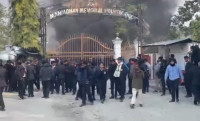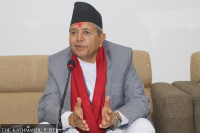National
Government amends Social Security Scheme rules to attract workers
Officials hope expanded protection for workers and more options will attract people to join the contribution-based social security scheme.
Chandan Kumar Mandal
With the aim of attracting more workers and employers to join the Contribution-based Social Security Scheme, the government has made several changes to the law governing the plan.
The second amendment to the Social Security Scheme Operating Procedures, 2018 widens the scope of coverage for beneficiaries and streamlines the access to the facilities available under the scheme.
The new changes have been rolled out in all four categories of support to either provide additional coverage to the contributors or relax the existing procedures to give workers more options.
“Contributors had complained that the government should make adjustments so that workers can withdraw money in times of need. Through this amendment we have not just extended the coverage, but also offered several options,” said Bibek Panthee, a spokesperson with the Social Security Fund Secretariat.
Under the social security scheme, workers are offered financial security under four categories—medical treatment, health protection, and maternity plan; accidents and disability plan; dependent family plan; and old-age security plan.
Under the medical treatment, health protection and maternity plan, which annually provides a maximum of Rs100,000 for medical expenses—Rs20,000 for Outpatient Department (OPD) treatment and Rs80,000 for Inpatient Department (IPD) for serious cases.
With the changes in the law, workers can now divert unspent financial support meant for OPD to other IPD treatment.
“A worker may use only Rs 5,000 from the OPD coverage amount. In such a case, they can divert the remaining fund for other health treatments,” said Panthee, also the deputy executive director of the Social Security Fund Secretariat.
From now onwards, the fund will also cover the expenses of male contributor’s spouse for additional six weeks after childbirth. Earlier, the health coverage duration for newborn was up to three months while the coverage for the mother lasted only till the delivery time.
“A contributor’s wife can access up to Rs100,000 from the plan for regular check-up, operation and other health expenses during pregnancy. But earlier the coverage duration would expire once the baby was born,” said Panthee. “Under the new plan, the coverage period has been extended up to six weeks after the childbirth.”
Similarly, pensioners can also continue to enjoy health coverage if they contribute some amount from their pension to the plan.
“Contributors will get their monthly pension amount after they turn 60. But this is also the time they start getting weak and need regular medical services. The fund now gives them the option to contribute some amount to continue to get health coverage,” said Panthee.
The government has also removed the maximum amount ceiling under the accidents and disability plan.
“Even if a worker was earning Rs500,000 or Rs800,000, they would get around Rs25,000 as a disability compensation. We have removed the maximum ceiling and now, the worker will receive his/her basic salary’s 60 percent,” said Panthee.
Dependent family of a foreign worker, who has been working in Nepal after receiving a labour permit and contributing to the fund, will also be getting Rs700,000 if they want to receive the compensation at once as per the new changes.
Every month, both employers and workers are required to contribute to the Social Security Fund. An amount equivalent to 31 percent of a worker’s basic salary—11 percent deducted from the worker’s monthly salary and 20 percent contributed by the employer— is deposited to the fund.
Of the total monthly contribution, 1 percent goes to medical treatment, health protection, and maternity scheme; 1.40 percent to accidents and disability plan; 0.27 percent to the dependent family plan; and 28.33 percent to old-age security scheme.
Now, the government has divided the total contribution to the old-age security scheme into 20 percent for the pension plan and 8.33 percent for the retirement plan.
Earlier, the contributor could either choose the pension plan or the retirement plan with all the 28.33 percent of the monthly contribution going for the old-age security scheme. With the new changes, the contribution to both pension plan and retirement plan will be mandatory.
“Earlier, there was the option to go for one of the plans. Now both plans will go parallel and monthly contribution to both plans will happen,” said Panthee. “The contribution to the pension plan will mean monthly support after they have reached 60 years of age whereas the amount deposited under the retirement plan can be withdrawn as per their convenience.”
Workers having to wait for the major chunk of their contribution until they turn 60 was one of the major drawbacks of the social security scheme. Last December, the government even rolled out credit facilities for workers so as to woo them to join the social security scheme.
“The new changes have helped address most of the confusions there were about the whole scheme,” said Janak Chaudhary, general secretary of the General Federation of Nepalese Trade Unions. “These new changes could attract the workers who were earlier reluctant to join the plan.”
According to Chaudhary, the new changes have also made it easier for registered workers to access health facilities from any hospitals if they can submit the original bill.
“We had long been raising concerns that workers should be allowed to access services from any hospital other than those recognised by the programme,” said Chaudhary.
With new changes, workers will also be able to access the amount deposited under the retirement plan before they turn 60.
“Mostly those with high monthly incomes had been complaining that their large sum was put on hold for years and that they could not access the money in times of need,” said Panthee. “Now they will get a monthly pension as well as a collective amount under the retirement plan which they can get any time.”
As per the new arrangements, 80 percent of the amount deposited under the pension plan can be withdrawn as a special borrow plan. Likewise, the government has provided more options for depositing more money to the retirement plan.
If a worker wishes to contribute more to the retirement plan, which already has his/her 8.33 percent of monthly contribution, he or she can also make other four types of deposits to the same plan.
The government has also provided another option to even divert already deposited 20 percent to the pension plan to the retirement plan if the worker registers and starts monthly contribution before the new fiscal year begins.
“The government has not only expanded coverage but also provided more options like withdrawing the amount when they need and depositing more amounts to the retirement plan,” said Panthee. “There might be some concerns in future, but most of the issues raised by workers and employers have been addressed.”
Labour rights activists like Chaudhary appreciates recent changes for expanding coverage for workers but thinks there are still challenges in making the scheme popular among workers.
“The point is how we are going to take these new initiatives to the common workers,” said Chaudhary. “The government needs to work with labour rights organisations and employers through a tripartite model to raise awareness regarding the scheme and its benefits.”




 13.12°C Kathmandu
13.12°C Kathmandu















